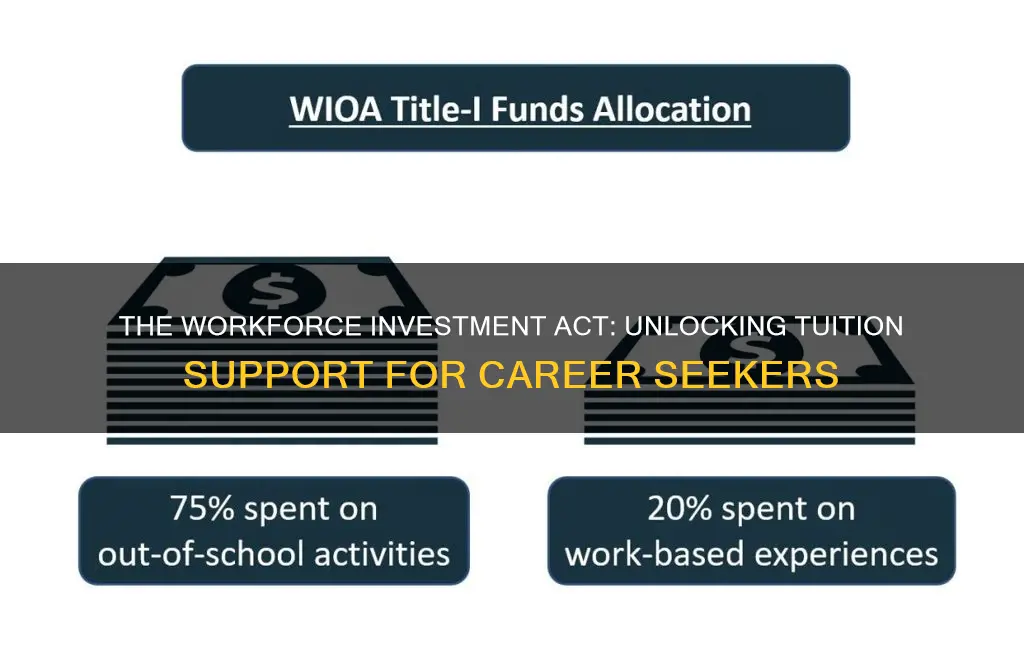
The Workforce Innovation and Opportunity Act (WIOA) is a federal program that provides tuition assistance to job seekers and individuals looking to improve their career prospects. The act, signed into law in 2014, aims to enhance career and job opportunities for workers and job seekers by connecting them with businesses through an integrated, job-driven public workforce system. WIOA offers a range of services, including tuition assistance of up to $7,000 per program, books, uniforms, supplies, and vocational guidance. To be eligible for WIOA benefits, individuals must meet certain criteria, such as being a dislocated worker, an adult between 18-72, or unemployed/employed below a certain income level. The program also provides employment and training services to help eligible individuals find meaningful employment and assist employers in finding skilled workers.
| Characteristics | Values |
|---|---|
| Name | Workforce Innovation and Opportunity Act (WIOA) |
| Year | 2014 |
| Purpose | Help job seekers access employment, education, training, and support services to succeed in the labor market |
| Tuition Assistance | Yes (up to $7,000 per program or $5,000/first year for undergrad tuition) |
| Applicant Criteria | Unemployed, people looking for new skills, job seekers, dislocated workers, eligible youth (aged 14-21), adults (18-72) |
| Support Services | Transportation, childcare, books, uniforms, supplies, vocational guidance, etc. |
What You'll Learn
- The WIOA program offers free tuition to job seekers
- WIOA Youth Program assists eligible youth in achieving employment and academic success
- WIOA Adult and Dislocated Worker Program provides employment and training services
- WIOA funding supports apprenticeship
- WIOA Financial Support Services provide funds or grants to pay for childcare and expenses

The WIOA program offers free tuition to job seekers
The Workforce Innovation and Opportunity Act (WIOA) is a federal program that provides free tuition to job seekers. The program was signed into law on July 22, 2014, and is designed to help job seekers access employment, education, and training to succeed in the labour market. It also helps employers connect with skilled workers to compete in the global economy.
The WIOA program offers tuition assistance of up to $7,000 per program, books allowance, uniforms/supplies, and vocational guidance. To be eligible for WIOA services, individuals must meet certain criteria, such as being a dislocated worker, an adult between the ages of 18-72, or a youth between the ages of 14-21. Dislocated workers are those who have been recently laid off or have received notification of an upcoming layoff. Adult applicants must be unemployed or employed at or below 200% of the Lower Living Standard Income Level (LLSIL), according to family size.
The WIOA program provides diverse and flexible services that can be customized to meet the applicant's exact needs. Employment counsellors from WIOA may offer training programs, grants, and free services to clients. This includes skills upgrading, job training, and educational services such as computer literacy, ESOL, GED preparation, and IT programming skills. WIOA also offers job readiness activities and search services, where counsellors work one-on-one with clients to help them find a job, prepare their application, and practice for interviews.
In addition to tuition assistance, WIOA provides financial support for other expenses. Income-qualified clients may be able to access funds or grants to cover childcare and transportation costs while participating in a job training program. WIOA also funds occupational skills training, which can provide individuals with a certificate or credential in hundreds of unique skill sets, including computer skills, new software products, and preparation for office or manufacturing jobs.
WIOA is a valuable resource for job seekers, offering a range of services and financial support to help them gain the skills and knowledge needed to succeed in their careers.
Investing: A Personal Choice
You may want to see also

WIOA Youth Program assists eligible youth in achieving employment and academic success
The Workforce Innovation and Opportunity Act (WIOA) is a federally funded program designed to assist eligible youth in achieving academic and employment success. The WIOA Youth Program provides a comprehensive array of youth services that help eligible in-school and out-of-school youth (aged 14-24) seeking assistance to achieve academic and employment success. The program includes 14 program elements that are made available to youth participants, with a minimum of 75% of funds allocated to out-of-school youth.
Program participants receive services such as occupational skills training, counseling, internships, job placements, mentoring, tutoring, leadership development, and support services. These services are tailored to meet the specific needs of the individual and may include tutoring, study skills training, instruction, evidence-based dropout prevention and recovery strategies, alternative secondary school services, paid and unpaid work experiences, occupational skill training, education offered concurrently with workforce preparation, leadership development opportunities, guidance and counseling, financial literacy education, entrepreneurial skills training, labor market and employment information, and activities that help youth prepare for and transition to postsecondary education and training.
WIOA funding can also be used to provide support services necessary to enable individuals to successfully participate in apprenticeship programs, such as tools, books, and uniforms. In addition, individuals interested in training for a new career may be eligible for assistance through WIOA, including tuition assistance (up to $7,000 per program), books allowance, uniforms/supplies, and vocational guidance.
To be eligible for the WIOA Youth Program, in-school youth must be attending school, be low-income, have one or more barriers to employment, and be between 14 and 21 years of age. Out-of-school youth must not be attending school, have one or more barriers to employment, and be between 16 and 24 years of age.
Your Guide to Choosing the Right Investment
You may want to see also

WIOA Adult and Dislocated Worker Program provides employment and training services
The WIOA Adult and Dislocated Worker Program provides supportive services and training services to eligible adults and dislocated workers. The program aims to help individuals find meaningful employment and assist employers in finding skilled workers to compete and succeed in business.
To qualify for the WIOA Adult Program, individuals must be 18 years of age or older and in need of workforce services, training, or retraining to secure unsubsidized employment. The program offers a range of services, including earn-while-learn training opportunities, no-cost tuition assistance for approved classroom training programs, and work readiness skills development.
The WIOA Dislocated Worker Program, on the other hand, is designed to help dislocated workers get back into the workforce as quickly as possible. A dislocated worker is defined as someone who has lost their job or received a layoff notice through no fault of their own. This program provides services through a national network of American Job Centers (AJCs), which offer significant resources for workforce education, training, and employment programs.
Both programs prioritize individuals receiving public assistance, low-income individuals, and those with basic skills deficiencies. Additionally, veterans receive priority in all DOL-funded employment programs.
The WIOA Adult and Dislocated Worker Program is just one of six core programs authorized by the Workforce Innovation and Opportunity Act (WIOA) to improve job and career options for workers and job seekers. The Act was signed into law on July 22, 2014, and represents a significant legislative reform of the public workforce system.
Investing: Choosing Companies Wisely
You may want to see also

WIOA funding supports apprenticeship
The Workforce Innovation and Opportunity Act (WIOA) was signed into law on July 22, 2014, as the first legislative reform of the public workforce system in 15 years. WIOA funding supports apprenticeship in several ways. Firstly, it provides funding for classroom training through individual training accounts (ITAs). These accounts are available to apprentices and can also be used to fund cohort training for a group of apprentices. Secondly, on-the-job training (OJT) is funded through contracts, with reimbursement typically covering 50% of the apprentice's wage rate. This can cover one or multiple apprentices.
Thirdly, WIOA formula funds can be used to provide support services such as transportation and childcare, ensuring that apprentices can fully participate in their programs. These funds can also be used to provide tools, books, and uniforms, which are essential for successful completion of apprenticeship programs. WIOA funding is particularly beneficial for low-income apprentices, helping to ensure they can access and complete their chosen programs.
WIOA funding is allocated to states based on a formula and is then passed on to local Workforce Development Boards, who decide on the allocation of funds. This funding is a vital source of support for apprenticeship programs, helping to improve job and career options for workers and job-seekers, and linking diverse talent to businesses.
France: A Smart Investment Move
You may want to see also

WIOA Financial Support Services provide funds or grants to pay for childcare and expenses
The Workforce Innovation and Opportunity Act (WIOA) is a federally funded program that helps adults, out-of-school youth, and dislocated workers to achieve self-sufficiency. The WIOA program is funded by the Department of Labor and administered by each state through local workforce systems. The WIOA provides funding for a range of supportive services, including transportation and childcare. These supportive services are available to individuals who require training to obtain employment and can be accessed through an Individual Training Account (ITA).
The ITA can be used to fund related training and instruction, as well as to provide supportive services such as childcare. On-the-job training (OJT) is funded through contracts and can cover one or multiple apprentices, with reimbursement typically at 50% of the apprentice's wage rate.
In addition to the WIOA program, there are other sources of financial assistance for childcare. These include state and local government programs, military assistance programs, employer-sponsored programs, and tax credits. Some specific examples include:
- Child Care Financial Assistance (also called vouchers, certificates, or subsidies) provided by states and territories to help low-income families with childcare costs.
- Head Start and Early Head Start programs, which offer free early learning and development services to eligible low-income families with children from birth to age 5.
- State-funded prekindergarten programs that serve children between 3 and 5 years of age and are offered at low or no cost to eligible families.
- Military child care financial assistance programs that help military families with childcare costs, regardless of where they are stationed.
- Local assistance and scholarships provided by nonprofit organizations and individual childcare providers.
- Tax credits, such as the Child and Dependent Care Tax Credit and the Earned Income Tax Credit, which can reduce the amount of tax owed and may result in a refund.
The Great Debate: PSLF or Investing – Navigating the Student Loan Dilemma
You may want to see also
Frequently asked questions
The Workforce Innovation and Opportunity Act (WIOA) is a federal program that helps unemployed people access resources to gain and improve their skills and manage their careers. It also helps companies find skilled workers.
To be eligible for the WIOA program, you must be either unemployed or have an income below the self-sufficiency guidelines as established by your state or county. Other eligible categories include the homeless, individuals with disabilities, or displaced homemakers.
The WIOA program offers free tuition to job seekers wishing to further their education and be more competitive in the job market. It also provides tuition assistance (up to $7,000 per program), books allowance, uniforms/supplies, and vocational guidance.
The WIOA program offers a range of benefits, including skills upgrading, job training, educational services, job readiness activities, search services, financial support services, and occupational skills training. It also provides temporary jobs and career planning services.
To apply for the WIOA program, you can contact your local community action agency or job center for specifics or referrals. You can also visit the website of the United States Department of Labor to learn more about the program and find resources near you.







